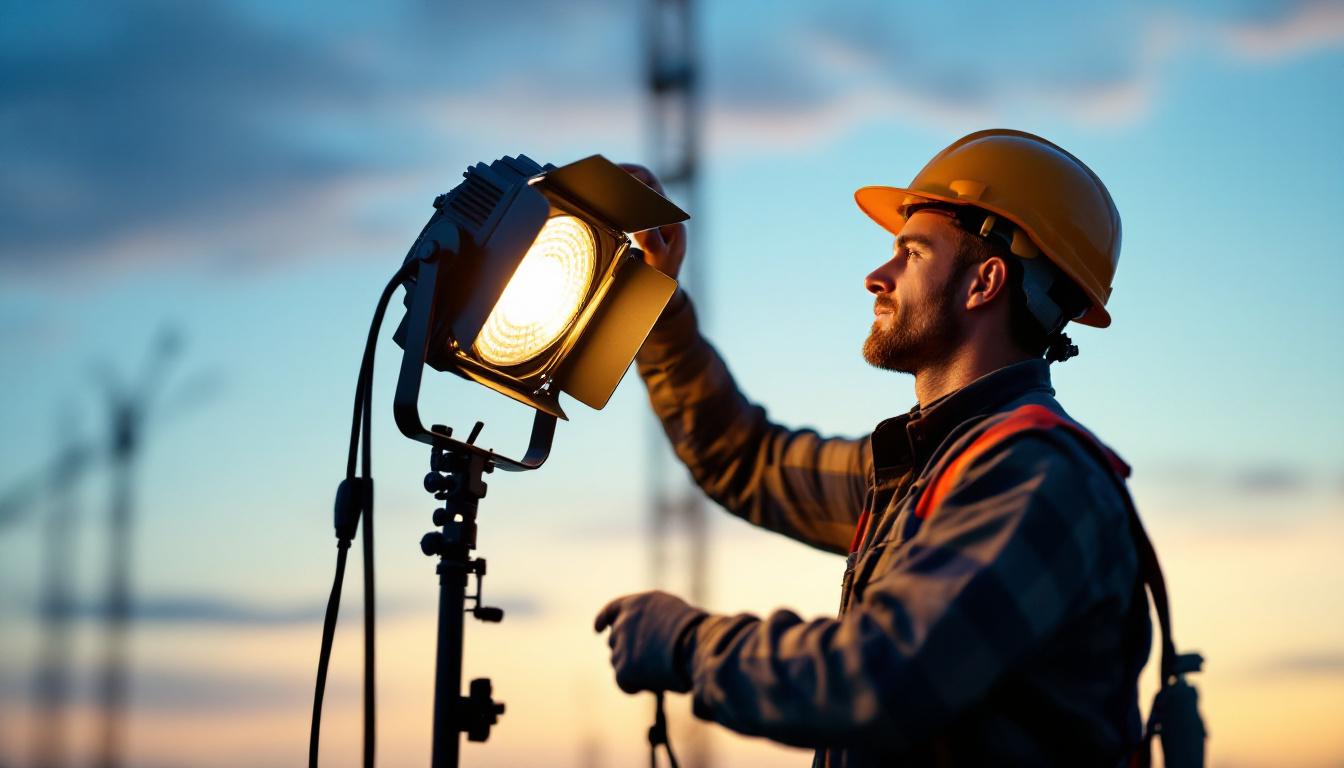
In the realm of construction, effective lighting is often overlooked, yet it plays a pivotal role in enhancing productivity and ensuring safety on job sites. For lighting contractors, mastering the art of jobsite lighting is essential not only for meeting client expectations but also for fostering a safe and efficient working environment. This article delves into the various aspects of jobsite lighting, offering insights and strategies that lighting contractors can employ to excel in their field.
Jobsite lighting is more than just illuminating a space; it is about creating an environment where workers can perform their tasks efficiently and safely. Poor lighting can lead to accidents, decreased productivity, and ultimately, increased costs for contractors. Understanding the significance of proper lighting is the first step for lighting contractors in mastering this crucial aspect of their work.
One of the primary reasons for investing in quality jobsite lighting is to enhance safety. Construction sites are often fraught with hazards, and inadequate lighting can exacerbate these risks. By ensuring that all areas are well-lit, contractors can help prevent accidents caused by trips, falls, or other mishaps. Additionally, proper lighting can improve visibility for machinery operators, reducing the likelihood of collisions or equipment-related injuries.
When workers can see clearly, they can perform their tasks more efficiently. Good lighting reduces eye strain and fatigue, allowing workers to maintain focus for longer periods. Moreover, well-lit job sites can facilitate better communication among team members, as visibility enhances collaboration. Lighting contractors should consider the specific tasks being performed when designing lighting solutions, ensuring that the right type of light is used in the right areas.
Compliance with safety regulations is crucial in the construction industry. Many jurisdictions have specific guidelines regarding jobsite lighting, and failure to adhere to these standards can result in penalties or project delays. Lighting contractors must stay informed about local regulations and ensure that their lighting designs meet or exceed these requirements. This not only protects the contractor but also instills confidence in clients regarding the contractor’s professionalism and commitment to safety.
Understanding the different types of jobsite lighting is essential for lighting contractors. Each type serves a unique purpose and is suited for specific conditions. By familiarizing themselves with these options, contractors can tailor their lighting solutions to meet the needs of various projects.
Temporary lighting is commonly used on construction sites where permanent fixtures are not yet installed. These lights are designed to be portable and easy to set up, making them ideal for job sites that are constantly changing. Options such as LED work lights, floodlights, and string lights offer flexibility and can be positioned to illuminate specific areas as needed. Contractors should consider the brightness, durability, and energy efficiency of temporary lighting solutions to optimize performance.
As projects progress and structures begin to take shape, the need for permanent lighting becomes apparent. This type of lighting is typically more robust and designed to withstand the elements. Options include wall-mounted fixtures, recessed lighting, and track lighting. When selecting permanent lighting solutions, contractors must consider factors such as the layout of the space, the intended use of the area, and energy efficiency. A well-planned permanent lighting system can significantly enhance the functionality of the completed structure.
Task lighting is essential for specific activities that require focused illumination. This type of lighting is particularly important in areas where precision work is being done, such as electrical installations or detailed carpentry. Lighting contractors should ensure that task lighting is adjustable and can be directed to where it is needed most. Options such as adjustable LED lamps or portable work lights can provide the necessary illumination for these tasks, improving accuracy and reducing the risk of errors.
Creating an effective jobsite lighting plan requires a thorough understanding of the project, the tasks involved, and the specific needs of the workers. A well-designed lighting plan can significantly impact safety and productivity on the job site.
Before designing a lighting plan, contractors must conduct a comprehensive assessment of the jobsite. This includes evaluating the layout, identifying potential hazards, and understanding the workflow of the project. By gaining a clear picture of the site, contractors can determine the best locations for lighting fixtures and the types of lighting that will be most effective.
Once the assessment is complete, the next step is to choose the right lighting fixtures. Factors such as brightness, color temperature, and energy efficiency should be considered. For instance, LED lights are often favored for their longevity and low energy consumption. Additionally, the color temperature can affect the mood and productivity of workers; cooler temperatures are generally better for tasks requiring focus, while warmer temperatures can create a more relaxed atmosphere.
After selecting the fixtures, contractors should create a detailed lighting layout. This layout should indicate the placement of each fixture, ensuring that all areas are adequately illuminated. It is important to consider the height and angle of the lights to minimize shadows and glare. Additionally, contractors should plan for flexibility, as job sites can change rapidly, requiring adjustments to the lighting setup.
Implementing best practices in jobsite lighting can elevate the quality of work and ensure a safer environment for all involved. Lighting contractors should be aware of these practices to enhance their services and client satisfaction.
Regular maintenance and inspections of lighting fixtures are crucial for ensuring optimal performance. Lights can become damaged or burnt out over time, leading to inadequate illumination. Contractors should schedule routine checks to replace bulbs, clean fixtures, and ensure that all equipment is functioning correctly. This proactive approach not only maintains safety but also demonstrates professionalism to clients.
Advancements in technology have led to the emergence of smart lighting solutions that offer enhanced control and efficiency. Lighting contractors should explore options such as motion sensors, dimmers, and programmable systems that can adapt to the needs of the job site. Smart lighting can reduce energy consumption and provide a more tailored lighting experience, ultimately benefiting both the contractor and the client.
Educating workers about the importance of lighting safety is essential. Contractors should provide training on how to identify areas that may require additional lighting and the proper use of lighting equipment. By fostering a culture of safety and awareness, contractors can empower workers to take responsibility for their environment, leading to a safer job site overall.
Examining real-world examples of successful jobsite lighting implementations can provide valuable insights for lighting contractors. These case studies highlight the impact of effective lighting on safety, productivity, and overall project success.
In a recent commercial construction project, a lighting contractor was tasked with designing a lighting plan for a large retail space. The contractor conducted a thorough assessment of the site, identifying key areas that required focused lighting, such as checkout counters and display areas. By incorporating a combination of ambient and task lighting, the contractor was able to create a well-lit environment that enhanced the shopping experience while ensuring safety for workers. The project was completed ahead of schedule, with positive feedback from both workers and management regarding the lighting quality.
During the renovation of an industrial facility, a lighting contractor faced challenges related to outdated lighting systems. The existing fixtures were inefficient and provided inadequate illumination for the tasks being performed. The contractor proposed a comprehensive lighting upgrade, replacing old fixtures with energy-efficient LED options and implementing smart lighting controls. The result was a significant reduction in energy costs and improved visibility throughout the facility. Workers reported increased satisfaction and productivity, and the client was pleased with the return on investment.
In a residential construction project, a lighting contractor focused on creating a warm and inviting atmosphere for the home. By utilizing a mix of ambient, task, and accent lighting, the contractor was able to highlight architectural features while ensuring functionality in key areas such as the kitchen and living room. The thoughtful lighting design not only enhanced the aesthetic appeal of the home but also contributed to a sense of comfort for the future occupants. The project received accolades for its design, showcasing the importance of effective lighting in residential spaces.
Mastering jobsite lighting is essential for lighting contractors looking to enhance safety, productivity, and overall project success. By understanding the importance of lighting, familiarizing themselves with different types of fixtures, and implementing best practices, contractors can create effective lighting solutions that meet the needs of their clients. Through careful planning, regular maintenance, and the use of innovative technology, lighting contractors can elevate their services and establish themselves as leaders in the industry.
As the construction landscape continues to evolve, staying informed about the latest trends and advancements in lighting technology will be crucial. By embracing these changes and prioritizing quality lighting, contractors can ensure that their job sites remain safe, efficient, and conducive to high-quality work.
Ready to take your jobsite lighting to the next level? At LumenWholesale, we provide lighting contractors like you with the highest quality, spec-grade lighting products at prices that can’t be beaten. Say goodbye to local distributor markups and hello to our extensive selection that meets rigorous industry standards. With free shipping on bulk orders, you can trust that you’re getting premium lighting at the best value — no hidden fees, no compromises. Elevate your lighting solutions with the quality, affordability, and convenience that only LumenWholesale can offer. Explore our wholesale lighting options now and light up your next project with confidence.

Discover essential tips and insights on selecting the perfect LED light sizes for your projects.

Illuminate your outdoor spaces with expert insights from lighting contractors.

Discover how recessed lighting can give lighting contractors a competitive edge in the industry.

Discover the transformative journey of LED light fixture components and their pivotal role in revolutionizing the lighting industry.